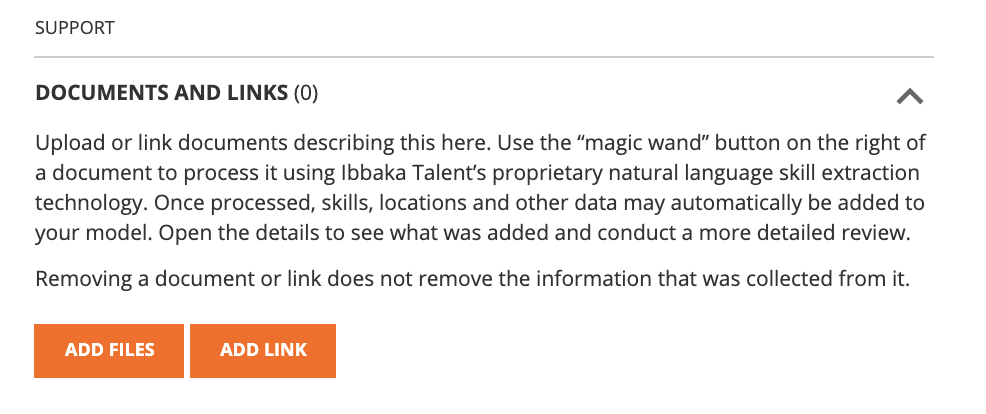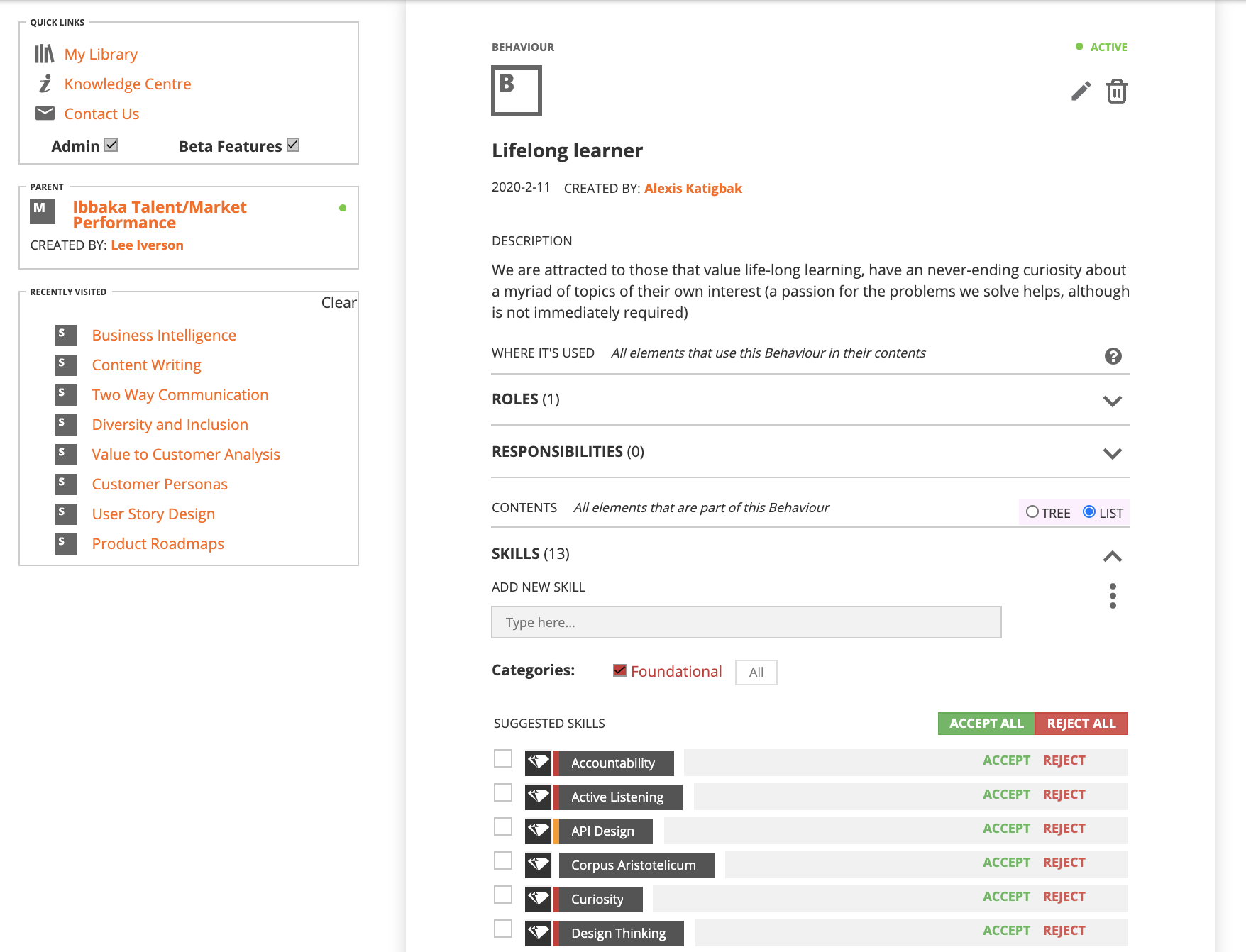From competency model design to competency model generation
Steven Forth is co-founder and managing partner at Ibbaka. See his skill profile here.
Competency models make talent management more effective. There is a surge of interest in these models, how to develop, apply and maintain them. Ibbaka does a great deal of work in this area and our platform is designed to empower all three of these activities:
Develop competency models (a focus of this post)
Apply competency models at the individual, team, organization and societal levels
Maintain models so that they remain relevant and current
Why all this interest? Competency models have many uses. Before we can talk about design we need to understand how they are used and what value they provide.
For individuals a competency model can be a template that shows them what skills they need to build and the behaviors they need to demonstrate for different career paths
For teams a competency model can help team builders understand the skills they need to fit together and set expectations for team members
For organizations a competency model allows it to shape the work environment and to use the competency model as a lens to look for concentrations of strength or skill gaps; one can even build multiple alternative models to explore different scenarios and future
For associations and other certifying bodies competency models are a way to define and communicate professional knowledge and practices, they are sometimes referred to as bodies of knowledge, such as SWE-BOK for the software engineering body of knowledge
For educators competency models can inform curriculums and then map back from curriculums to job requirements
For governments and workforce planners competency models together with job and occupation data help with workforce planning and guide many investments
As a result, there has been a lot of interest in how to make competency models more effective and to tame some of the complexity that surrounds the field. This is why the IEEE Learning Technology Standards Committee has been sponsoring the work of the 1484.20.1 Data Model for Reusable Competency Definitions and the 1484.20.2 Defining Competencies groups. There is also work being done at the skills level, by groups such as the World Economic Forum (WEF) and the Open Skills Network (OSN).
The design of competency models
The design of competency models is a specialized skill set and is not (yet) widely distributed. David Botta at Ibbaka is currently beginning a design research project into how different competency model designers approach their work. This is inspired by the work that Nigel Cross and others have done on other design processes.
The general process as we currently understand it can be summarized as follows:
Understand the purpose of the model, who will use it, how it will be used, the value this is intended to create for individuals, teams, organizations and society at large
Gather information, such as job descriptions, team mandates and charters, organizational designs, examples of work products, other skill and competency models from related areas (which may go by other names such as curriculums or bodies of knowledge or even guides to certification) - you may want to include whole large chunks of other models
Interview practitioners, talk to the people who actually have the skills and do the work, learn what they do, the activities and tasks they carry out, the behaviors that shape their work
Architect the model, decide what the different parts will be and how they will be connected, consider the underlying data architecture and integration architecture as these will shape and be shaped by the competency. model architecture
Develop the model by filling out the architecture, which could range from identifying the Jobs and Roles to be included, describing the behaviors, and defining the skills and levels of expertise required; one may even need to add learning resources to make the model complete
Review the model with the people who will apply it and with people skilled in the areas it covers (subject matter experts or SMEs play a big role in competency model development)
Test the model in the field, with people in all sorts of different roles, to see if it is really helping the teams and individuals it is meant to help
Roll out the model to the people who need it, in a staged and supportive way, which may require some level of change management
Connect the model to other systems — models often get connected to the HRIS or talent management system or to learning and development systems, but also to resource allocation, project management, applicant tracking and even knowledge management systems
Evolve the model to make sure that it stays current
Of course the details of how this is done vary across experts and disciplines, and the applications to which the model will be applied. That is why we are doing design research in the area. If you are interested in contributing to research in this area please contact us at info@ibbaka.com.
If all this looks like a lot of work, it is. And it gets worse. Skills and competencies change constantly. Heard of Keras? If you haven’t you likely will soon, as it is a powerful collection of APIs for building artificial intelligence. As the design and implementation of AIs becomes more common, we will see Keras as a tool in more and more skill profiles and it will surface into competency models soon, if it has not already done so.
In fact it is so much work to maintain competency models that two things tend to happen. Once the model is developed and rolled out people heave a sigh of relief and move on to other things. As a result, the model begins to decay until it is no longer useful. One senior HR person said to us that rolling out a competency model leads to ‘competency model PTSD.’ And if you look through your current models you will find that most of them are already out of date.
We don’t want that.
So how can the Ibbaka Platform help?
In the development phase, Ibbaka becomes a place where you can gather and connect all of the links and documents you are referencing.
Ibbaka does more than simply hold the documents. It runs its skill extraction AI on them to find relevant skills that you may want to include in the model.
These skill suggestions are generated by our AI, but they come from several different places. The most interesting of these is the skills associated with roles and the skills of people with these roles.
This is useful when building a new competency model and it is even more important in keeping a model current.
(The Skill Graph is Ibbaka’s underlying data model and data, it connects skills to skills, to competencies, jobs, roles, behaviors and to people. It even connects people to people based on their skills, the teams they have worked on and the roles they have played.)
By connecting a Job or Role in a competency model to my Skill Profile I can get skill suggestions, see my skill gaps and invite people to comment on the skills I am using in a role. All of these interactions are collected into the Skill Graph and processed by the Skill AI. The Skill AI builds associations between Skills, Jobs, Roles, Competencies, Behaviors and other components in your competency model. In this way, emergent skills can be bubbled up into the competency model which stays current and evolves to reflect the real skills being used in Job Roles and on Teams.
Further processing can be done to start to understand which skills are driving outcomes, so that the combination of people, AIs and skills is working together to become more intelligent and more effective.
Competency models that are not connected to skill profiles become dead documents. Competency models trapped in HRIS and talent management systems are too limited in scope to be useful and tend to stagnate. To succeed in the emerging world of skill and competency management you need to think in terms of a system, not a list or document, and that system needs to support the dynamic connections between people and their skills.
Ibbaka Posts on Competency Models and Competency Frameworks
From user experience to competency model design - Margherita Bacigalupo and EntreComp
Competency framework designers on competency framework design: The chunkers and the slice and dicers
Competency framework designers on competency framework design: Victoria Pazukha
Design research - How do people approach the design of skill and competency models?
From competency model design to competency model generation (this post)
The Skills for Career Mobility - Interview with Dennis Green
Lessons Learned Launching and Scaling Capability Management Programs
Talent Transformation - A Conversation with Eric Shepherd, Martin Belton and Steven Forth
Individual - Team - Organizational use cases for skill and competency management
Co-creation of Competency Models for Customer Success and Pricing Excellence
Competencies for Adaptation to Climate Change – An Interview with Dr. Robin Cox
Architecting the Competencies for Adaptation to Climate Change Open Competency Model
Integrating Skills and Competencies in the Talent Management Ecosystem
Organizational values and competency models – survey results













